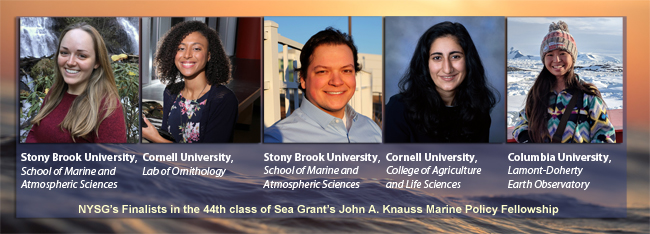
Continuing the tradition of placing early career professionals in D.C.-based federal government offices, NOAA and Sea Grant are pleased to announce the finalists for the 2023 class of the Sea Grant John A. Knauss Marine Policy Fellowship program. The 2023 class, which includes five from New York, represents the largest in recent years with 86 finalists.
— By Chris Gonzales, Freelance Science Writer, New York Sea Grant
New York, NY, August 1, 2022 - New York Sea Grant (NYSG) congratulates five finalists in the 44th class of Sea Grant’s John A. Knauss Marine Policy Fellowship (Knauss Fellowship). Starting early next year, among the fellowship program’s 86 national finalists will be Lisa Crawford, Amelia-Juliette Demery, Noah Khalsa, Omisha Manglani, and Rebecca Trinh. All hail from universities in New York State — Stony Brook University (Crawford and Khalsa), Cornell University (Demery and Manglani), Columbia University (Trinh) — and bring expertise and experience from across the United States, the Americas, and the world.
“New York Sea Grant is beyond excited to announce this year’s amazing cohort of John A. Knauss Marine Policy Fellow Finalists from New York universities,” said Becky Shuford, director of NYSG. “Each of these early-career professionals hosts an incredible array of experiences, backgrounds, and credentials that they will bring to the positions in federal agencies and congressional offices, working at the nexus between marine and Great Lakes environmental policy and science.”
Starting this fall, the five will join the other 2023 finalists from across the nation to virtually interview with federal offices that work on or have interest in coastal and marine science and policy issues. NYSG's finalists will be placed in federal government offices in Washington, D.C. — Manglani and Khalsa in legislative and Trinh, Demery, and Crawford in executive — for one-year fellowships that begin next February.
“With geographic scopes from Antarctica to Alaska, California to Costa Rica, the waters of Long Island in New York State and Cape Cod in Massachusetts, all the way to India and the Himalayas, and in many places in between and beyond, from studying birds to sharks to crustaceans, shellfish, microbes and bacteria,” Shuford continued, “these five Knauss finalists are change agents; ambassadors of diversity, equity, inclusivity, and justice, and they are each true leaders. We are thrilled to see how they will bring their skills and enthusiasm to bear to make tangible impacts as they transform the environmental, research, and policy landscape. Please join us in warmly welcoming Amelia, Lisa, Noah, Omisha, and Rebecca to the Sea Grant family.”
NYSG’s 2023 Knauss Finalists: In Their Words
Lisa Crawford
Stony Brook University, School of Marine and Atmospheric Sciences
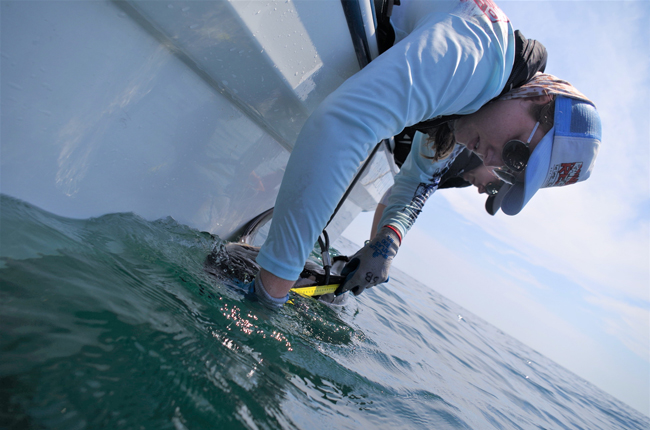
Lisa Crawford takes measurements of the length of a sandbar shark by holding a measuring tape to the tip of the nose and passing the end to the other person in the photo. The cable around the body is used to stabilize very large animals or animals that spit out the hook and need to be controlled from the front. Credit: Mike Frisk
“I am incredibly excited and grateful to be chosen as a Knauss finalist. As I conclude my Ph.D. in marine science [at Stony Brook University’s School of Marine and Atmospheric Sciences], I am thrilled by the opportunity to apply my academic background to a new discipline to advance my lifelong goal to champion the oceans. I can't wait to meet my cohort and make new friends and colleagues.”
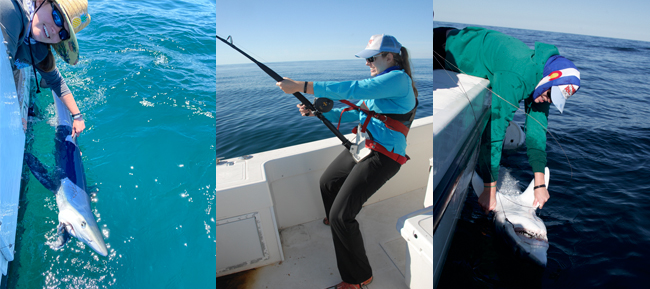
(At left) Lisa Crawford goes shark fishing while studying local New York sharks for her dissertation work on shark toxicology. Her team does all their work hanging over the side of the boat. This way they can keep the shark in the water so it can breathe and be easily released. She takes measurements as well as blood and tissue samples for her research. You can see the piece of bait still on the line that the blue shark didn’t quite eat. Credit: Jim Miller; (Middle) “I had a common thresher shark on the line, the first shark I ever angled, and I was working on landing it boat-side,” says Crawford. Credit: Charlie Witek; (At right) “This was the first shark I ever handled in the wild,” says Crawford. “I’m holding the shortfin mako shark upside down in tonic immobility; when you flip a shark over, they fall asleep and we’re able to safely draw blood and take measurements.” Credit: Mike Frisk
Amelia-Juliette Demery
Cornell University, Lab of Ornithology

Amelia-Juliette Demery, who is currently working towards her Doctoral Degree in Evolutionary Biology at Cornell University, visits the Cornell University Museum of Vertebrates, studying a radiation of toucans. She is interested in the genetics behind avian color, specifically in beaks and eyes, and how these can change color over the course of a single bird’s lifetime. Credit: Cornell Sloan Foundation
“I grew up in southern California and now live in upstate New York. I’ve had the privilege to enjoy all that our natural areas have to offer, as well as see firsthand the challenges they face in the wake of a changing climate, inequitable resources and accessibility, and the dynamic needs of our society. I use my research to discover insights into the networks that shape how organisms change across space and time, and I'm so excited and honored to bring that toolkit into the Knauss Fellowship.
With this fellowship, I hope to gain more strategies and opportunities to apply a scientific lens to policy design and implementation. It is my hope that, with the Knauss Fellowship, I can leverage the hard efforts of research and innovation to improve the lives and livelihoods of our communities for years to come.”

(At left) Demery holds a barn swallow in her hand. As one of the graduate students at the Cornell Lab of Ornithology, she has the privilege to go out and trap birds in order to study their life history and ecology. Credit: Dr. Sarah Khalil; (At right) Demery steadies a mist-net, made to capture European Starlings at the Cornell University Ruminant Center. She seeks to understand how starlings change their beaks over the course of their lifetime, and what that means in terms of genetic expression and variation. Credit: Dr. Anusha Shankar
Noah Khalsa
Stony Brook University, School of Marine and Atmospheric Sciences

Noah Khalsa, who is currently working towards his Master’s degree in marine science at Stony Brook University’s School of Marine and Atmospheric Sciences, is aboard the R/V Sikuliaq in the Bering Sea, AK. Credit: Anne-Lise Ducluzeau
“Being born and raised in Alaska, I developed a unique appreciation for the socioeconomic importance of ocean resources. Building on this, as a fisheries technician with the Sitka Tribe of Alaska during college, my eyes were opened to the value of involving stakeholders in resource management.
As a Knauss fellow, I intend to further develop my skills as a fisheries scientist while contributing to the crafting of science-based and stakeholder-oriented marine resource management policies.”

(At left) In Kachemak Bay, Alaska, Khalsa attaches a SeaFET oceanographic instrument to a dock piling in order to monitor ocean acidification. Credit: Amanda Kelley; (At right) Khalsa downloads data and services a SeaFET used for monitoring coastal environmental conditions in the Arctic. This photo was taken in Prudhoe Bay, Alaska. Credit: Kyle Gatt
Omisha Manglani
Cornell University, College of Agriculture and Life Sciences
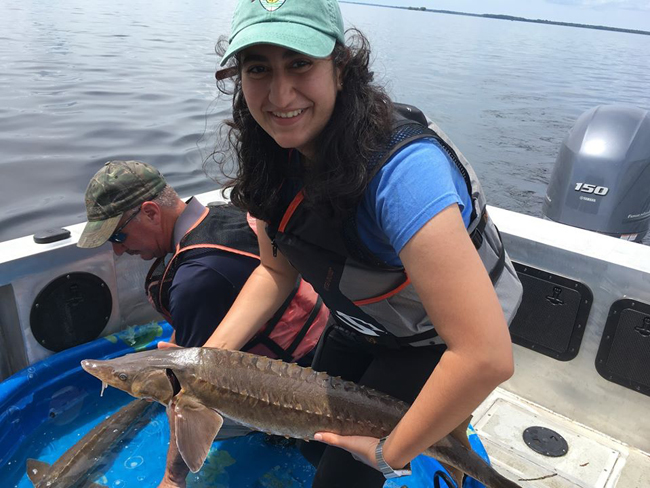
Omisha Manglani on NY’s Oneida Lake in summer 2019 when she was an intern at the Cornell Biological Field Station. She and her fellow team members caught, tagged, and released lake sturgeon (a threatened species) during an annual lakewide survey. Manglani is a Class of 2022 Masters of Science Candidate in Environmental and Indigenous Studies at Cornell University's College of Agriculture and Life Sciences. Credit: Manglani
“Growing up in a coastal city, I witnessed the deterioration of marine ecosystems and, subsequently, of marginalized communities that relied on their ecosystem. In the time of rapid environmental degradation and inequitable impacts on marginalized communities, especially amid a global pandemic, policymakers face a crucial responsibility to forge a more just and sustainable new normal.
My career goal is to protect coastal communities through a synergy of education, outreach, and effective science-based policymaking focusing on environmental justice.
As a Knauss fellow, I look forward to advocating for communities of color, and low-income and indigenous communities through my practical training in building coastal resilience, knowledge co-production, and climate change adaptation.”

(At left) In Spiti Valley of the Trans-Himalayas in the summer of 2019, Manglani conducts a preliminary research visit for a participatory action research endeavor that she is currently implementing. Credit: Manglani; (At right) In Spiti Valley in the summer of 2016, Manglani converses with a local of Spiti near a stupa. Credit: Nina Negi
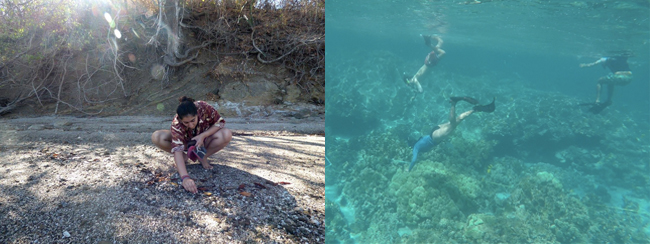
(At left) Manglani observes marine debris and shells on the coast of Playa Naranjo, Costa Rica. A lifelong nature-lover, she's had the privilege to travel, build community, and study the environments that she's lived in. Credit: Nina Negi; (At right) Manglani snorkeling in Kealakekua Bay, Hawai’i to survey coral reef health; a research endeavor to analyze the long-term impacts of tourism on the Big Island. Credit: Dr. Charles Greene
Rebecca Trinh
Columbia University, Lamont-Doherty Earth Observatory
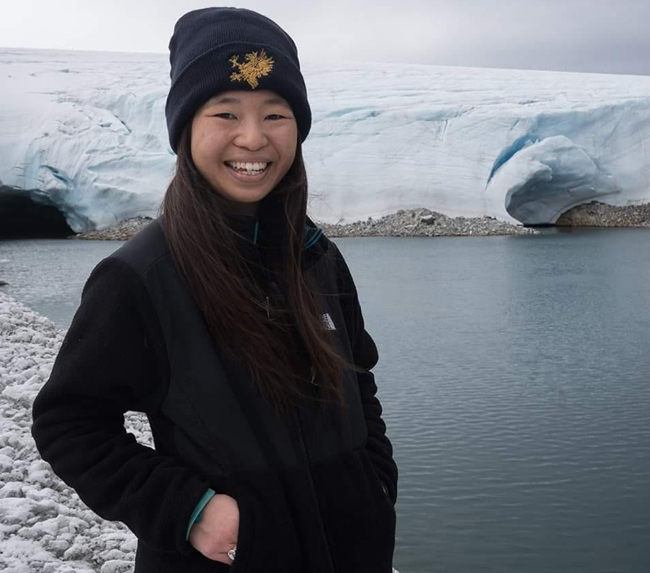
Trinh — posing in front of the glacier of Palmer Station, Antarctica, where she spent three field seasons — is a Doctoral candidate at Columbia University's Lamont-Doherty Earth Observatory (Department of Earth and Environmental Sciences). Credit: Trinh
“I am a biological oceanographer specializing in ecological drivers of marine carbon cycle in Antarctica. The marine carbon cycle plays an outsized role in global climate and is expected to change as the planet warms.
Through the Knauss Fellowship, I am looking forward to working with senior scientists and policy makers on protecting our marine ecosystem. Ocean protection is one way to help stall the effects of global climate change and I am looking forward to learning how to craft and implement holistic solutions to pressing environmental concerns.”

(At left) Trinh navigates the sea ice in Antarctica along with her fellow team members (not pictured); (Middle) The yellow equipment is a sediment trap Trinh uses to study ocean carbon export in Antarctica; (At right) While in Antarctica, Trinh operates equipment on a small boat to sample water chemistry and biology. Credit: Trinh
More Info: Knauss Fellowship
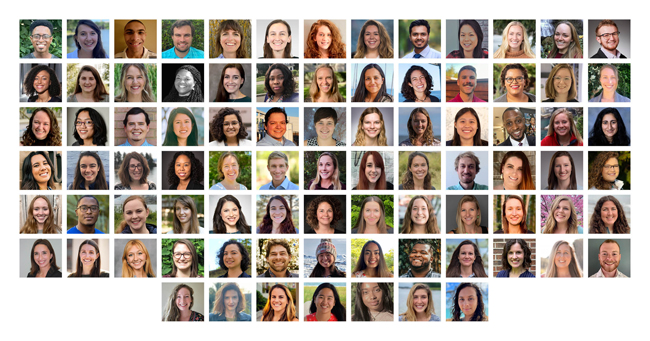
The 86 finalists in the 2023 class of the Sea Grant John A. Knauss Marine Policy Fellowship program. Learn about the different paths to the fellowship for these talented early career professionals: bit.ly/Knauss-2023-Finalists.
“The Knauss Fellowship offers graduate students the invaluable opportunity to put their academic knowledge to practice in tackling marine, coastal, and Great Lakes management and policy challenges at the federal level,” said Jonathan Pennock, National Sea Grant College Program director. “We look forward to welcoming the 2023 class of Knauss fellows and seeing how they will apply their unique insights to developing solutions to some of the most important challenges facing the country.”
This year’s class of 86 finalists comprises students and recent graduates from 62 distinct universities, including 16 finalists from nine minority-serving institutions. The finalists represent 29 of the 34 Sea Grant programs, and they completed coursework and research in a range of fields, such as biology, chemistry, ecology, engineering, environmental science and management, law, marine and coastal sciences and policy, and several disciplines of oceanography.
Last year, 51 executive fellows in the 2022 class of the Knauss Fellowship secured placements for their fellowship year. The finalists were placed in offices across NOAA and other federal agencies during Sea Grant's virtual Placement Week, held in October 2021. The current fellows include three from New York — Giselle Schmitz (now working in the National Oceanic and Atmospheric Administration's National Marine Fisheries Service — Office of Science and Technology), Liang Wu (NOAA's Office of Ocean Exploration and Research), and Celeste Naoko Zumwalt (NOAA HQ — Office of the Under Secretary).
Students finishing graduate programs such as master's, doctor of philosophy, and juris doctor, with a focus and/or interest in marine and coastal science, policy or management can apply to the John A. Knauss Marine Policy Fellowship Program via one of 34 state Sea Grant programs. Applicants who are successful at the state level advance, and their applications are reviewed by a national panel. You’ll find further details about the fellowship at www.seagrant.noaa.gov/Knauss and you can keep up with current and previous Knauss fellows from across the country at www.seagrant.noaa.gov/knauss-blog.
Since 1979, over 1,550 fellows have completed the one-year Knauss fellowship program, applying their experience to lasting careers in science, policy, and public administration. Learn all about the Knauss Fellowship in a video from the National Oceanic and Atmospheric Administration's National Sea Grant College Program: https://bit.ly/Knauss-video. The application period and guidance for 2024 fellowships will open in Fall 2022.
More Info: New York Sea Grant
New York Sea Grant (NYSG), a cooperative program of Cornell University
and the State University of New York (SUNY), is one of 34 university-based
programs under the National Oceanic and Atmospheric Administration’s
National Sea Grant College Program.
Since 1971, NYSG has represented a statewide network of integrated
research, education and extension services promoting coastal community
economic vitality, environmental sustainability and citizen awareness
and understanding about the State’s marine and Great Lakes resources.
Through NYSG’s efforts, the combined talents of university scientists
and extension specialists help develop and transfer science-based
information to many coastal user groups—businesses and industries,
federal, state and local government decision-makers and agency managers,
educators, the media and the interested public.
The program maintains Great Lakes offices at Cornell University, SUNY
Buffalo, SUNY Oswego and the Wayne County Cooperative Extension office
in Newark. In the State's marine waters, NYSG has offices at Stony Brook
University in Long Island, Brooklyn College and Cornell Cooperative
Extension in NYC and Kingston in the Hudson Valley.
For updates on Sea Grant activities: www.nyseagrant.org has RSS, Facebook, Twitter, Instagram, and YouTube links. NYSG offers a free e-list sign up via www.nyseagrant.org/nycoastlines for its flagship publication, NY Coastlines/Currents, which is published quarterly.